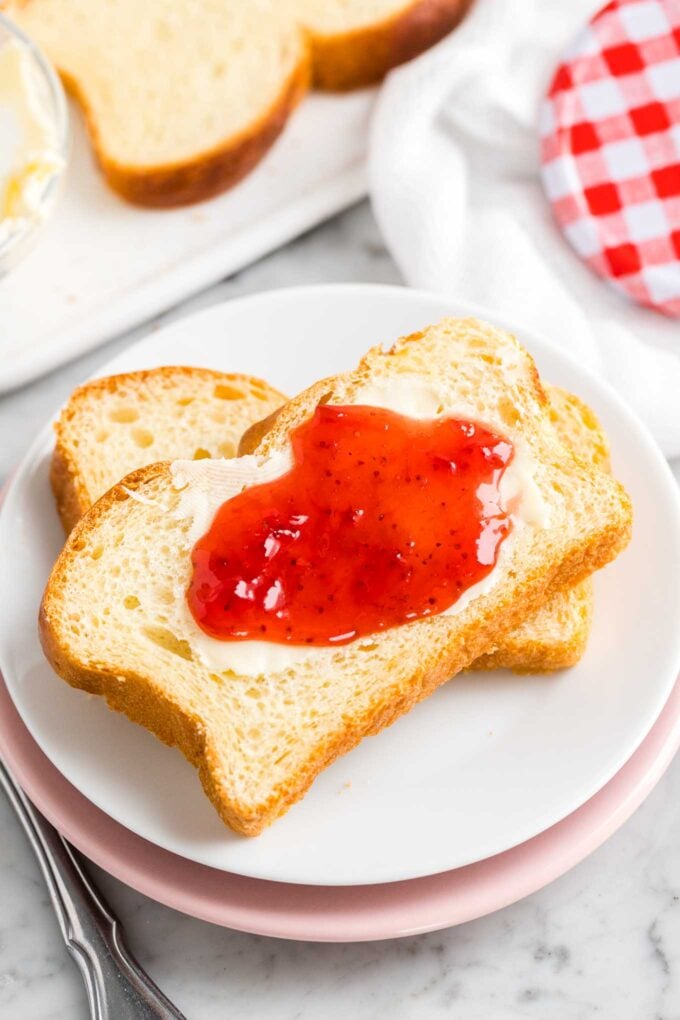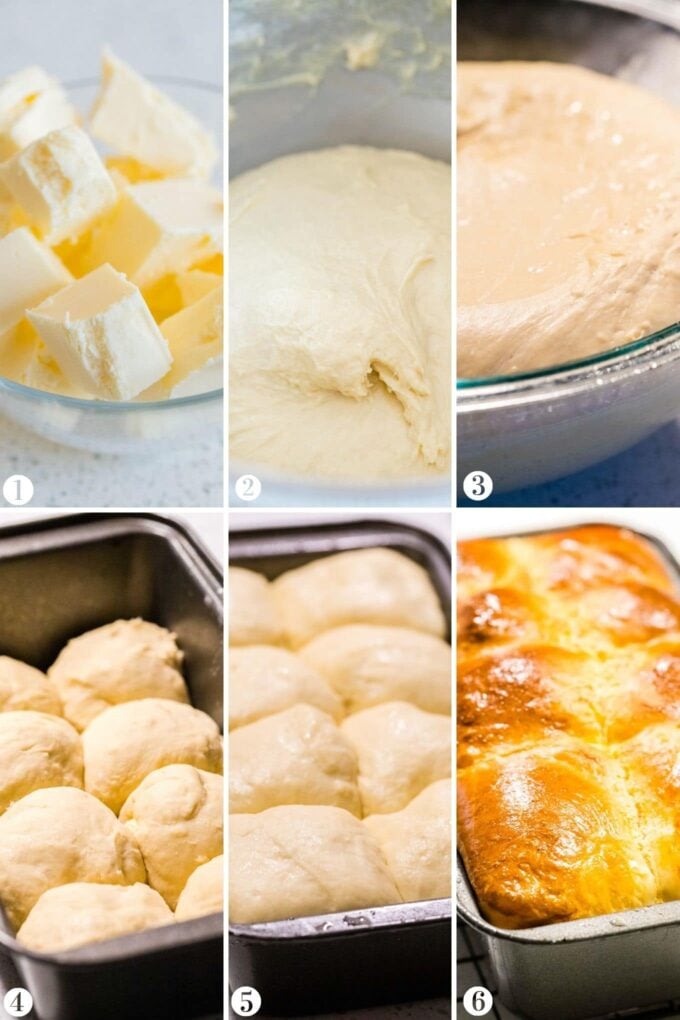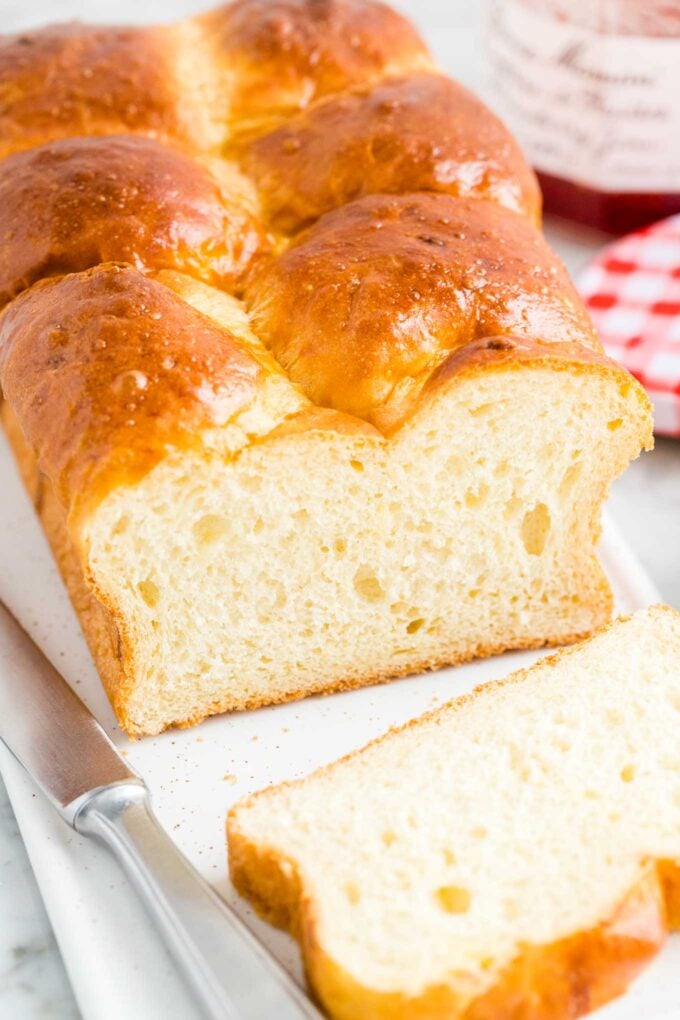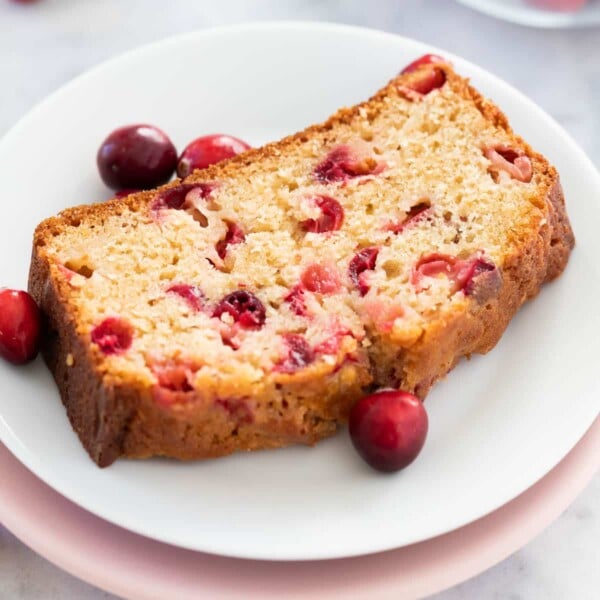This post may contain affiliate links.Please read our disclosure policy.
Brioche bread is rich, buttery, and easy to bake at home. Try this simple recipe that is perfect for making French toast and never go back to store-bought!

A glorious, golden French brioche loaf is a thing of beauty. Flaky, tender bread with a rich crumb and slightly sweet, buttery taste throughout. Perfect for french toast but also great for sandwichs!
This treat is a favorite find in bakeries around the world. As incredible as this bread looks and tastes though, it’s just as easy to make in your home kitchen with this simple bread recipe, just like my white bread or my braided bread.
What is Brioche?
Brioche bread is a Viennoiserie – meaning that it’s a traditional yeast bread but with eggs, butter, and sugar added to the dough. The additions make the finished product richer and denser, yet lighter and flakier. It has its roots in 15th Century France and is thought by many to be the perfect balance of sweet and savory in bread form.
Similar kinds of bread in the Viennoiserie family that you may have tried before:
- Challah – This bread has a similar golden appearance to brioche, but because it’s Kosher, it doesn’t include dairy products or butter. As a result, it’s a bit denser and less sweet than brioche bread.
- Hawaiian Bread – This bread may actually be the closest match to French brioche in terms of flavor, but it does have less fat and actually incorporates potato flour to keep the bread feeling fresh longer.
- Portuguese Sweet Bread – Believe it or not, this is the same exact thing as Hawaiian bread! Who knew?!
My favorite uses for this bread
Hands down, my favorite use for this bread is to make brioche French toast. They are a perfect pair! The eggs in the bread make it denser than regular bread. As a result, it is not as likely to become soggy when soaking up the egg and milk mixture. With the perfect balance between sweet and savory, it begs for any kind of toppings you want to pile on.
But French toast is just the tip of the iceberg for this brioche bread recipe. It’s also great for brioche bread pudding, french toast casserole, sandwiches, and even tastes great plain!

Step-by-Step Instructions
- Prep butter: Cut the butter into cubes and let them sit at room temperature for 20 min.
- Make the dough: By kneading it for about 10 minutes the gluten gets activated and the dough will become elastic and pull away from the side of the bowl.
- First rise: Transfer dough to a greased bowl and cover with greased plastic wrap. Let rise at room temperature until doubled in size, about 1 hour.
- Shape: Grease two 8×4 pans. Punch down the dough and divide it into 16 equal pieces. Roll into balls and place eight balls in each baking pan.
- Second rise: Cover pans with greased plastic wrap and let the dough rise until doubled in size, about 45 min. The second rise is always faster than the first!
- Bake: Preheat oven to 350 degrees F. Brush loaves with egg and bake for 30-35 minutes until loaves are golden brown.
Recipe Ingredients
Because the ingredients in French brioche are simple, each one of them is important:
Bread Flour: The difference between bread flour and all-purpose flour is, that bread flour has a higher protein content – usually around 11-14%. All-purpose flour is between 9-11%. This means the bread flour produces a chewier, stretchier, more bread-like bake. Using all-purpose flour would change the texture of the bread!
Instant Yeast: Just like flour, when it comes to yeast there are a few different varieties. The most common in supermarkets today are RapidRise (from Fleischmann’s), Active Dry, and Instant yeast (which is what our brioche bread recipe calls for). While they will all give your bread the rise it needs, Instant Yeast does it at the speed which works best for this French brioche.
Butter: The best butter to use to make this recipe is unsalted butter. This is because salted butter can actually contain up to 13% more water than unsalted. As a result, it might affect the structure and texture of the finished loaf, as well as the rise before baking. Also, make sure your butter is room temperature/soft – but not melted. If not, you may end up with a cake instead of a bread loaf.

Expert Tips and FAQ
Kneading: A stand mixer works best but you can also need the dough by hand or use a hand mixer. By kneading it for at least 10 minutes (15 minutes by hand) the gluten gets activated and the dough will become elastic and pull away from the side of the bowl. This also prevents the dough from collapsing after the second rise, which usually happens because of large air bubbles that form after insufficient kneading.
Storage: Loaves can be stored in zipper-lock bags at room temperature for up to 2 days.
Freezing: A brioche loaf freezes beautifully! Make sure to allow time for it to cool before freezing. This prevents it from getting soggy. After the bread is cool, double wrap it in plastic wrap, freezer paper, or aluminum foil. Be cautious to ensure that the wrapping is airtight. This helps to prevent freezer burn. You can also freeze slices, perfect for French toast. To thaw a loaf of brioche, allow it to sit at room temperature for at least three hours.
Make ahead: After covering pans with plastic wrap in step 4, refrigerate for up to 24 hours. Let loaves sit at room temperature for 2 hours before proceeding with the recipe; increase baking time by 5 minutes.
Other popular recipes made with yeast
If you’ve tried this or any other of my recipes, don’t forget to rate the recipe and to leave me a comment. I love hearing from you! You can also follow me on PINTEREST, FACEBOOK, or INSTAGRAM to never miss a recipe.

Brioche Bread
Ingredients
- 4 cups bread flour, spooned and leveled
- 1 Tbsp instant yeast, or rapid-rise yeast
- 1 1/4 cups water, room temperature
- 5 large eggs, lightly beaten
- 1/4 cup sugar
- 2 tsp salt
- 3/4 cup unsalted butter, cut into 12 pieces and softened
Instructions
- In the bowl of a stand mixer, fitted with the dough hook, combine flour and yeast. Add water and 4 of the eggs. Mix on low speed until no dry flour remains. Scrape down frequently. Cover bowl with plastic wrap or a tea towel and let sit for 15 minutes.
- Add sugar and salt to the bowl and knead on medium speed until incorporated. With the mixer running, add butter, one piece at a time, mixing after each addition until each piece is incorporated. Scrape down the bowl, then knead for 10-15 minutes until the dough is elastic and pulls away from the side of the bowl.
- Transfer dough to greased bowl and cover with greased plastic wrap. Let rise at room temperature until doubled in size, about 1 hour.
- Grease two 8×4 pans. Punch down dough in the bowl, turn out onto floured work surface and divide the dough into 16 equal pieces. Roll into balls and place eight balls in each baking pan. Cover pans with greased plastic wrap and let dough rise until doubled in size, about 45 min.
- Preheat oven to 350 degrees F. Lightly beat remaining egg and brush over loaves (you don’t need to use all of it). Bake loaves for 30-35 minutes until loaves are golden brown and register 205 to 210 degrees in center, rotating pans halfway through baking.
- Let loaves cool for 15 minutes on a cooling rack, then remove loaves from pans and let cool completely.
Notes
Helpful Tips
- Use bread flour, not all-purpose flour.
- Make sure the yeast is alive.
- The water should be room temperature or lukewarm, it should not be hot.
- The butter should be room temperature. Your finger should make an indent without sliding down into the butter. It shouldn’t be too soft.
- By kneading it for at least 10 minutes (15 minutes by hand) the gluten gets activated and the dough will become elastic and pull away from the side of the bowl.
- Loaves can be stored in zipper-lock bags at room temperature for up to 2 days or frozen for up to 1 month tightly wrapped to prevent freezer burn.











The oven timing was way off. Turned out great but during the beating time after I added the butter, I added several tablespoons of flour.
So I have a question… can you make this bread without a stand mixer unfortunately I don’t have one yet :(
A hand mixer with dough hooks will work too!